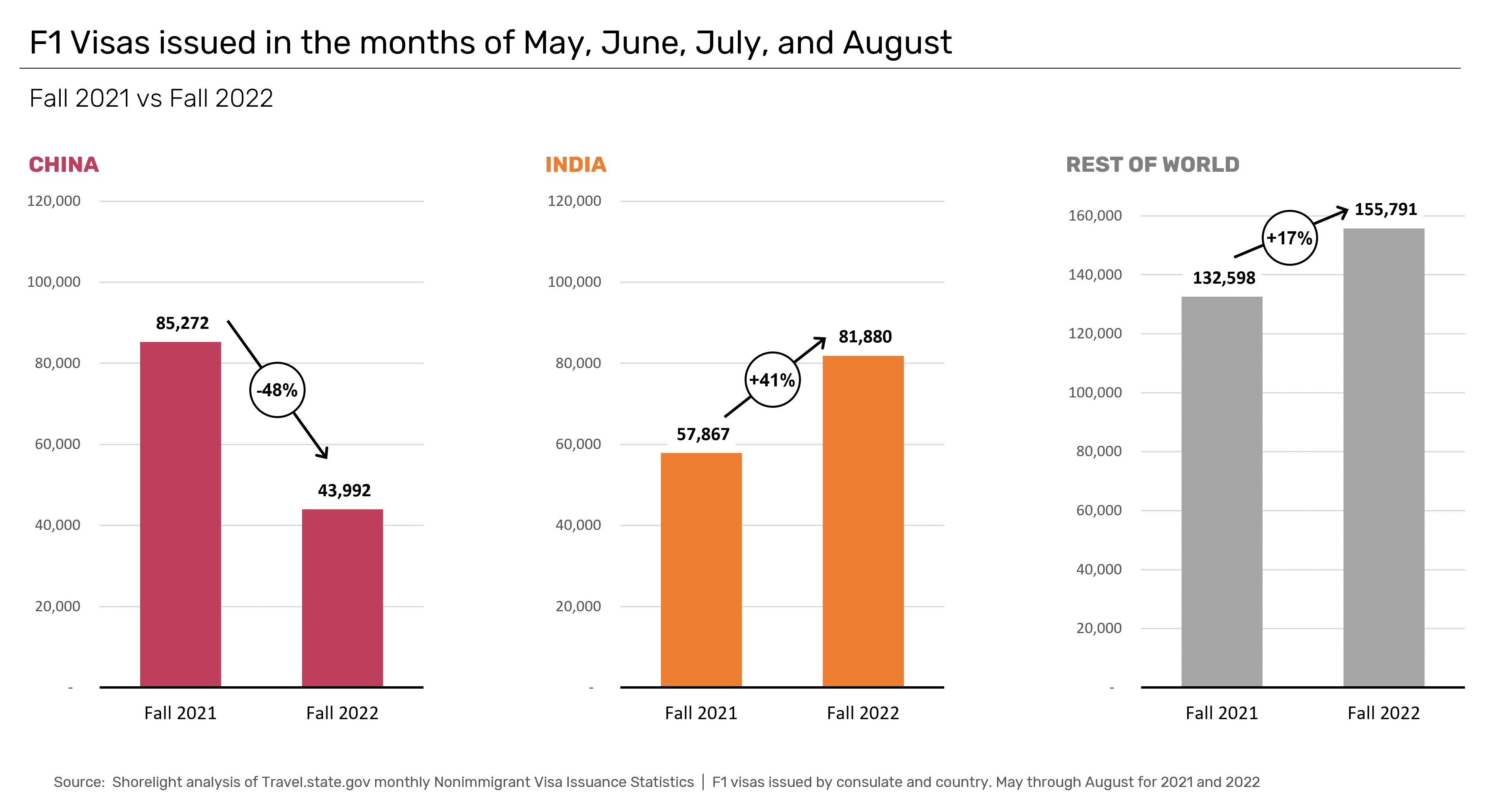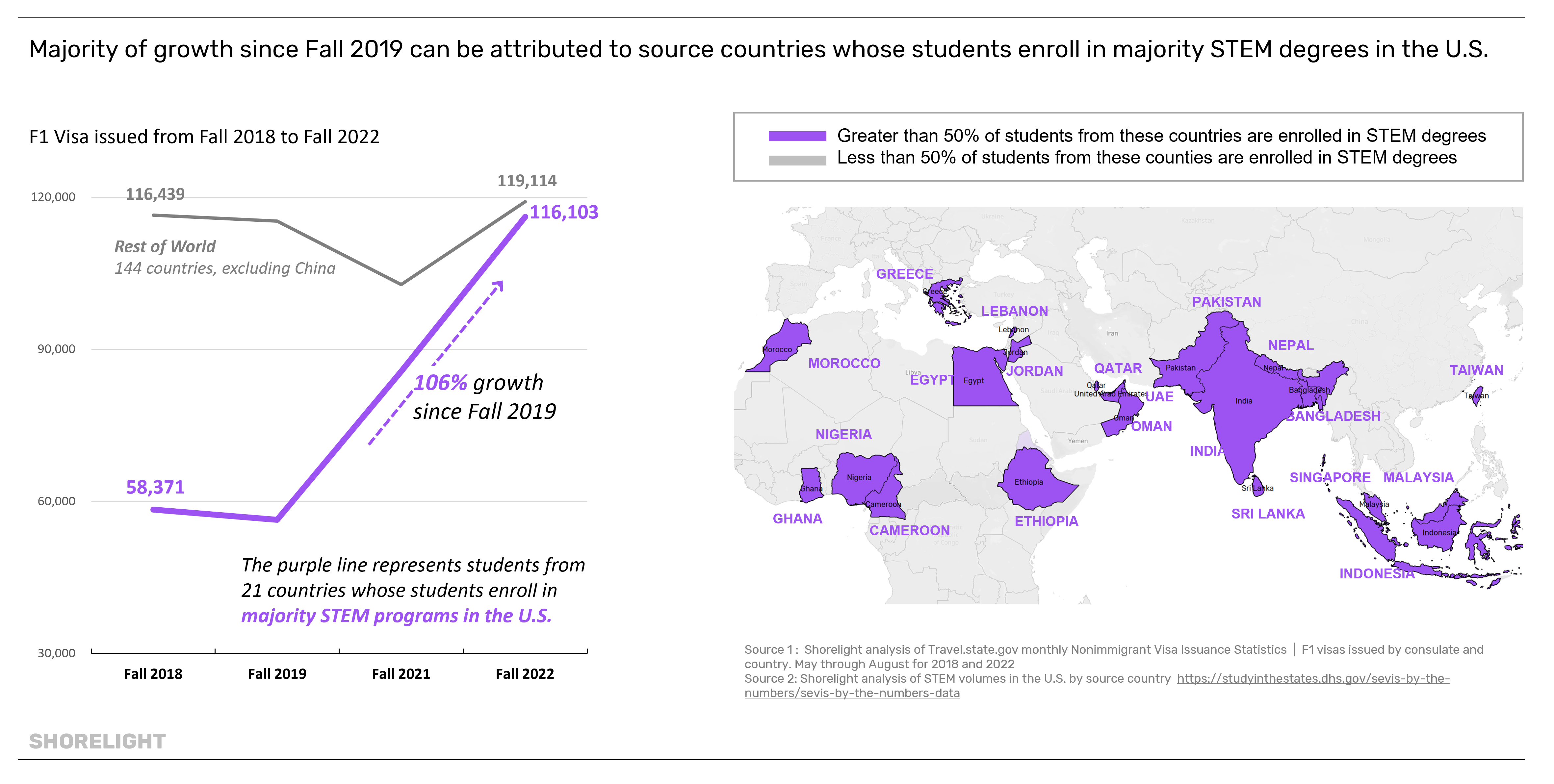An analysis of the Fall 2022 intake shows international education is strongly recovering after the pandemic, and the vast majority of countries sent more students to study in the US this fall than they did the previous year.
The Shorelight Analytics and Data Science team looked at visa issuance data published by the US Department of State to understand changes between the Fall 2021 and Fall 2022 intake. A total of 142 countries showed growth in student visa issuances, while only 22 countries showed a decline in student visas, indicating that the demand to study in the US remains strong. While it’s unsurprising that certain countries like India and Vietnam continued to experience robust growth, demand from African countries is growing rapidly.

It’s important to note that in Russia and Ukraine, the zero visas shown on the map are due to consular offices in the country being closed. Ukrainian and Russian students wishing to study in the US had to travel to another country’s consular office to get a visa, and are accounted for in other countries’ totals.

Worldwide, more international students are studying in the US in Fall 2022 than they were pre-pandemic in 2019. Shorelight analyzed visa data during the months (May through August) that students are most likely to seek a visa. Between Fall 2021 and Fall 2022, there was a 2% overall increase in F-1 visas for a total of 281,663 visas.
“Fall 2022 is the first large intake after the pandemic where the number of new students demonstrates a more accurate picture of demand for US higher education, versus in Fall 2021 when many students wanted to enroll but still had to defer due to the pandemic,” Brian Meagher, who leads Shorelight’s Marketing and Analytics Team, said. “With 2% growth in F-1s and 51% growth in J-1s, this is the type of new student demand the US has needed to see after stagnating pre-pandemic.“
J-1 visas for short-term and non-degree-seeking students also showed growth. J-1 exchange programs allow students to gain practical training not available in their home country and require the training to be directly related to their academic program.
“An increase in J-1s shows there’s diversity in demand for US higher education and is a sign of a healthy international education industry,” Meagher said.
With the majority of the world showing strong growth, it’s important to note that the 2% increase would have looked much different if India and China, the two largest source countries to the US, were removed from the data.

Without China or India, the rest of the world experienced a 17% increase in student visas issued from Fall 2021 to 2022.
“The growth we’re seeing in the rest of the world is extremely positive. In previous years, China was the big driver, and there weren’t a lot of growers historically. While China and India continue to make up a large portion of the demand for a US education, it’s a really positive sign to see the diversity of growth coming back into play,” Meagher said.
The 2% overall increase in demand would have been much higher without a significant yet unsurprising decrease in student visas issued from China. Fall 2022 is the first intake post-covid where we see the true extent of the changing demand. In Fall 2021, over 80,000 Chinese students were issued visas to study in the US. Enrollment decreased to just under 44,000 in Fall 2022, which marks a 48% decrease.
Many universities that have long relied on strong enrollments from China will be feeling the economic impact of the ongoing decline. However, these new trends will be encouraging for schools that have focused on diversifying their global recruitment strategies. While China and India remain incredibly important to US international education, this data confirms the need for expanding US recruitment strategies.
The decline in China is nearly leveled by growth in India year over year. There were nearly 58,000 F-1 visas issued to Indian students in 2021, which grew by 41% in 2022 for a total of 81,880 Indian students. The skyrocketing demand meant consular offices, still understaffed compared with pre-pandemic levels, were at capacity processing a record enrollment. Shorelight is encouraged to see India exceed its Fall 2021 enrollment as the state department assesses its resources to meet what we expect will be increasing demand.
The growth in India shows the importance of not only evaluating where demand is coming from but why so many international students are pursuing an international education. Shorelight data shows one primary driver is an abundance of world-class STEM programs. A total of 86% of Indian students studying in the US are enrolled in a STEM degree program, according to our analysis of SEVIS STEM data from May 2022.
When Shorelight looked at STEM demand in other countries, it was clear India’s high enrollment in STEM is not just a blip.

Shorelight data shows that since 2019, 21 countries that sent more students to STEM programs than to other degree programs are growing at a much faster rate than other growing countries.
“Even though the US only grew 2% in terms of new student visas, countries that are more STEM-oriented grew double or grew at a faster rate than other countries,” Meagher said.
The makeup of the representative international student in the U.S. has changed and will continue to evolve. Even though international students and families have always seen the US degree as a means to stand out in the job market or open new career opportunities, today’s international student is far more pragmatic in their approach to deciding what to study and where to study than in the early 2000s or the 2010s.
“STEM-based degrees and student experiences focused on outcomes will drive the next wave of international demand to the US, and we’re poised as a country to capture this opportunity if we do it right,” Meagher said.
While previous reports showed that many STEM-oriented countries are in South Asia, Shorelight’s most recent analysis shows several African countries are experiencing rapid growth because of the demand for STEM. Universities looking to expand their recruitment of top STEM talent should consider boosting recruitment efforts in Africa. According to the United Nations World Population Prospects, “over 60% of Africa’s population is currently under 25, with Africa containing 19% of the global population of 15- to 24-year-olds. By 2035, sub-Saharan Africa will have a working population larger than the entire rest of the world combined. In contrast, other workforces in the world are aging.” As the international student landscape shifts, it is important to understand global growth and to be prepared to engage with students from emerging markets.
The data analyzed by Shorelight shows an undeniable rebound in education and strong growth worldwide. While India and China remain the large source countries, the higher education industry can learn a great deal from the changing demand and try to adapt. To take full advantage of the strong growth in demand the world is experiencing, Shorelight will continue to analyze data focusing on changes in student mobility and degree choices. The data revealing double-digit growth in STEM will be the focus of upcoming research.
Shorelight will also work with others in the higher education sector to build upon the Department of State and Education’s Joint Statement of Principles that renew its commitment to international education. It is time for the current administration to take action. A national recruitment strategy will allow the US to play a vital role in global growth to increase America’s scholarly, research and development and innovation communities, which is critical to its global leadership, economy, and strength.

